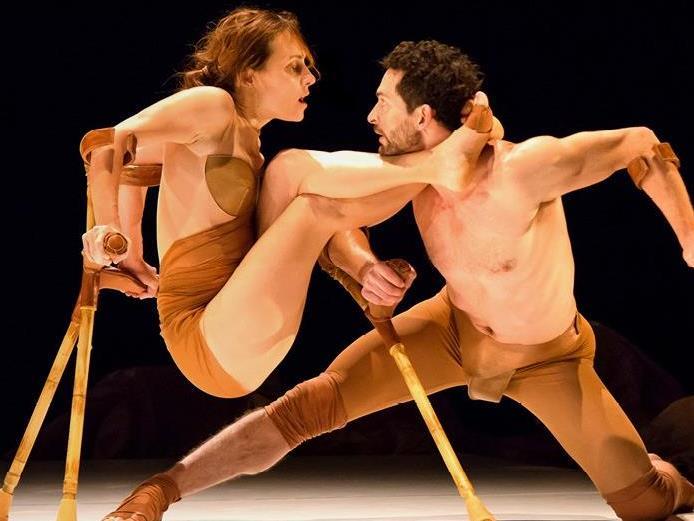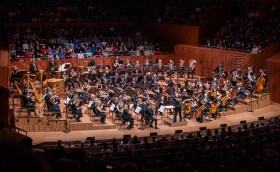Triptyque. Image by Alexandre Galliez.
Sometimes words have limited use in describing art certain forms. It is such a fluid interweaving play of physical precision and visual poetry that is to be found in the three pieces that make-up Les & Doigt’s Triptyque that their audience’s standing ovation may be the most articulate expression of the calibre of their work.
The twenty minute, first piece opens with dancer Sara Harton hanging in a Kinbaku Japanese bondage entrapment (designed by Isabelle Hanikamu); red rope twisted around her, suspended on a long low rod of bamboo. It is choreographed by Marie Chounard, a long established international solo performer with her own dance company.
The stage is enclosed by a large square moat of what sounds like rocks and paper, as they are slushed through by Harton and Sameul Tetreault later in the piece. A simply narrative emerges as Tetreault drags himself onto the stage on low crutches to tenderly untangle his love and to be demasked by her.
Both performers move with crutches and inhabit a way of being that makes them resemble caryatids and is compelling to watch. Outside the square, separated, they walk strong on their legs, but close to each other they appear collapsed and riven with ecstasies of the spirit which is consummated by their final union. Rich violin classical music fills the auditorium as these two beings enact their violent passion. It is a technically flawless balance of circus technique and sincere expression; their alien beauty leaves the audience breathless.
The second piece is an upside-down world, choreographed by Victor Quijada, a US performer based now in Montreal. Thumping rhythm articulates the work with an electronic music score. The work opens with the six performers balancing in handstands on high, vertical metal rods secured to the ground, one under each hand. The forest of legs begins to move to the music in rhythmic unison, not in synchronised movement, but with each expressing their own individual movements. It is this ability for the company to conflate extraordinary physical prowess with a dance interest in personal vocabulary that brings such life to the pieces. It also speaks of the street culture of hip hop in which each dancer contributes their own way of moving. The piece sees various interplays of the performers over the length of this forty minute feast of flawless inverted prowess. An extraordinary grace is exhibited in the soft flow of movement by a hand-standing female artist; her resemblance to a jelly fish is played with as a second artist brushes her to make her respond like a tentacle touched by coral.
The third piece follows the intermission. The sheer quantity of content in the show is unlike a typical dance performance. The stage is now rigged for aerial work with long white ropes appearing. It opens with a large white bed, sat upon by Sara Harton, as she watches television, lit by its blue light. A male suitor appears to arrive at an invisible door, and the piece unfolds a world of surreal emotional events.
Choreographed by Spanish-origin Maros Morau, his work reveals a delightful and fresh embrace of multi-references and multi-disciplines. Television sound bites, spoken word, circus flair, clowning, contemporary dance and an embrace of the theatrical tableau are used by Morau. With Goya like intensity, he reveals how successfully the disorientating visual effects of circus tricks visually translate into an expression of the irrational world of the human interior. At one point the bed suddenly lifts to swing on massive cables tipping its sleeper perilously as she scrabbles to remain thirty feet aloft by hanging on to the sheets while another performer balances in a handstand above her head on the bedhead. Characters slip out and under the bed with inhuman lightness. Bodies contort beyond what would appear possible and then appear with massive fish heads, resembling a hallucination. And people spin and swing through the air, as the central character threads herself through the dreamscape to end finally collapsed on the bed. The danger of the performer’s feats, their extraordinary gymnastic strength and agility becomes forgotten amidst the visual impact of their collective enterprise.
Formed in 2002, the Quebec based company’s ‘new form’ of circus/dance puts an end to any concept of compromise being the outcome of a conflation of the once quite distinct disciplines of circus and dance. Triptyque represents the ascent of circus away from shallow spectacle into deeper expressive realms and is a fascinating exposition of a circus proposition informed by the dramaturgical coherence set by dance.
Rating: 4 stars out of 5
Triptyque
By Les 7 Doigts
Creator and Director Samuel Tétreault
Invited Choreographers Marie Chouinard, Victor Quijada and Marcos Morau
Arts Centre
As part of Melbourne Festival
6-9 October 2016





